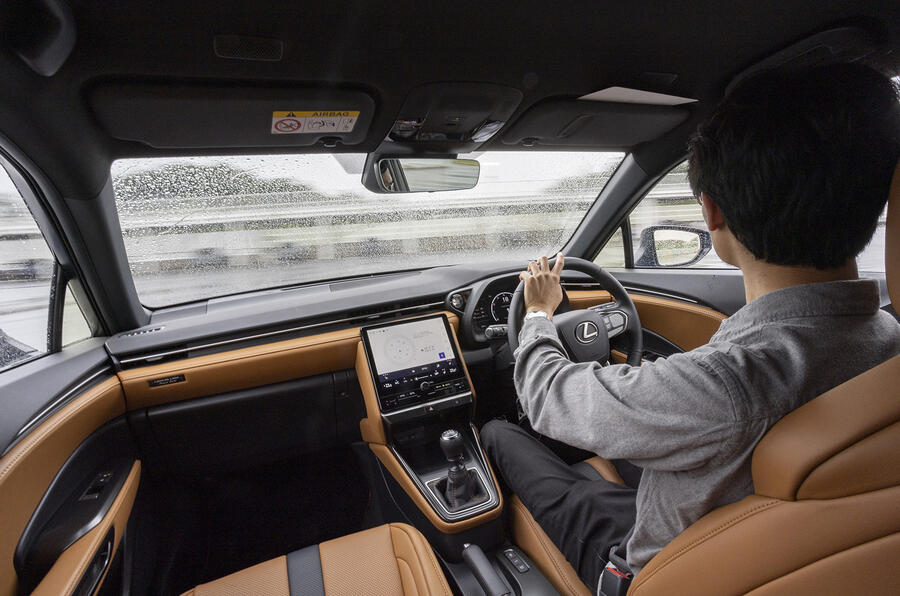Small SUV now comes with fire in its belly, courtesy of a Toyota GR Yaris powertrain. We drive an early prototype.
Some of us might see the letters ‘RR’ and think it stands for Rolls-Royce or Range Rover, but now there’s another option: Rookie Racing.
Lexus will start to use RR to designate its high-performance models (think of it as the equivalent of a GR-badged Toyota) and the first one to arrive will be the Lexus LBX Morizo RR. Morizo refers to the racing alter ego of Toyota chairman Akio Toyoda, while RR stands for Rookie Racing, the firm’s motorsport team that competes in Japan’s version of Formula 2 and touring car championships.
The regular LBX does a pretty convincing job of being a small, upmarket SUV, but the Morizo RR livens things up by ditching the usual fuel-saving hybrid set-up for the engine and four-wheel drive system from one of the most exciting hot hatchbacks we’ve seen in ages: the Toyota GR Yaris.

On the outside, it’s 15mm wider and 10mm lower than the standard Lexus LBX, and it comes with 19in forged alloy wheels, grippy Continental Sport Contact 7 tyres and a pair of prominent tailpipes. The wheel-arch trims are now body-coloured rather than grey and you can opt to have the brake calipers in yellow, the RR brand’s signature colour.
In Japan, the car's ‘GE16E-GTS’ 1.6-litre turbocharged triple produces 300bhp, but it’s worth noting the GR Yaris is slightly detuned for European markets to meet emissions regulations, so it seems logical the LBX Morizo RR may follow suit – if it is sold outside of Japan, that is. Yes, unfortunately, we’ll have to wait until later this year before we find out if this model will head to Europe.
As it stands, a 0-62mph time of 5.2sec makes it significantly quicker than a similarly sized Ford Puma ST Powershift, at 7.4sec, and just a little behind the Volkswagen T-Roc R’s 4.8sec time. However, unlike those two rivals, you can choose to have the LBX Morizo RR with a six-speed manual gearbox. A short throw and a precise, meaty clutch pedal make it far more engaging to drive than the eight-speed automatic version (despite the auto changing gear quickly and smoothly enough), and there is a switchable iMT rev-matching system to help smooth out your downshifts.
That’s not all, though. Since the manual version has been designed with a sharper focus on fun, it also comes with a manual handbrake to give the driver more control – handy, if you fancy living out your rally driver fantasies.
Even so, the auto version is predicted to be the more popular choice for its versatility. It’s still capable of a few hot laps around a track, but it’ll be more relaxing to pootle home in – especially if you switch to the car’s default Normal drive mode, where it shifts up a gear as soon as possible and keeps a lid on the engine and exhaust noise levels. Switch to Sport and it holds onto gears for longer, but you’ll need to knock the gearlever into M mode if you want to take full control using the shift paddles mounted on the steering wheel.
Sport mode also pipes an artificial engine note through the sound system and the exhaust will subtly crackle when you lift off the accelerator. In the manual version, Sport is the default mode.
The four-wheel drive system natively favours the front wheels (in a 75:25 split) but will divert up to 50% of the power to the rear axle to boost traction when needed. However, press the AWD Mode button and power is permanently split 50:50 between the front and rear axles, providing a more neutral power delivery.
Even on a heavily rain-soaked track during Japan’s rainy season, where we drove a prototype version, it really doesn’t take long to build up confidence and press the accelerator pedal sooner to slingshot your way out of a bend. Meanwhile, body lean is well controlled, the steering responds accurately and there’s plenty of grip from the front tyres to help you place the car exactly where you want. You can even indulge in a bit of lift-off oversteer if you want.
Fans of the GR Yaris may notice there isn’t a mode for a more rear-wheel-drive bias to the power delivery and the firm acknowledges that if you want the most fun or effective tool for frequent high-performance driving, a Toyota GR product is still the way to go. The RR is more for those who occasionally want to enjoy its high-performance potential but value comfort and keeping their heart rate a little lower once away from that environment.
At a time when new, fun, pure-petrol cars are about to become extinct (we’ve only just said goodbye to the Lexus LC 500’s atmospheric V8), the creation of the LBX Morizo RR certainly lifts our spirits.
Technical specifications: Lexus LBX Morizo RR prototype
Price: tbc, Engine: 3 cyls inline, 1618cc, turbocharged, petrol, Power: 300bhp at 6500rpm, Torque: 295lb ft at 3250-4600rpm, Gearbox: 6-spd manual, 4WD, Kerbweight: 1440kg, 0-62mph: 5.2sec, Top speed: tbc, Economy: tbc, CO2, tax band: tbc, Rivals: Ford Puma ST, Volkswagen T-Roc R


